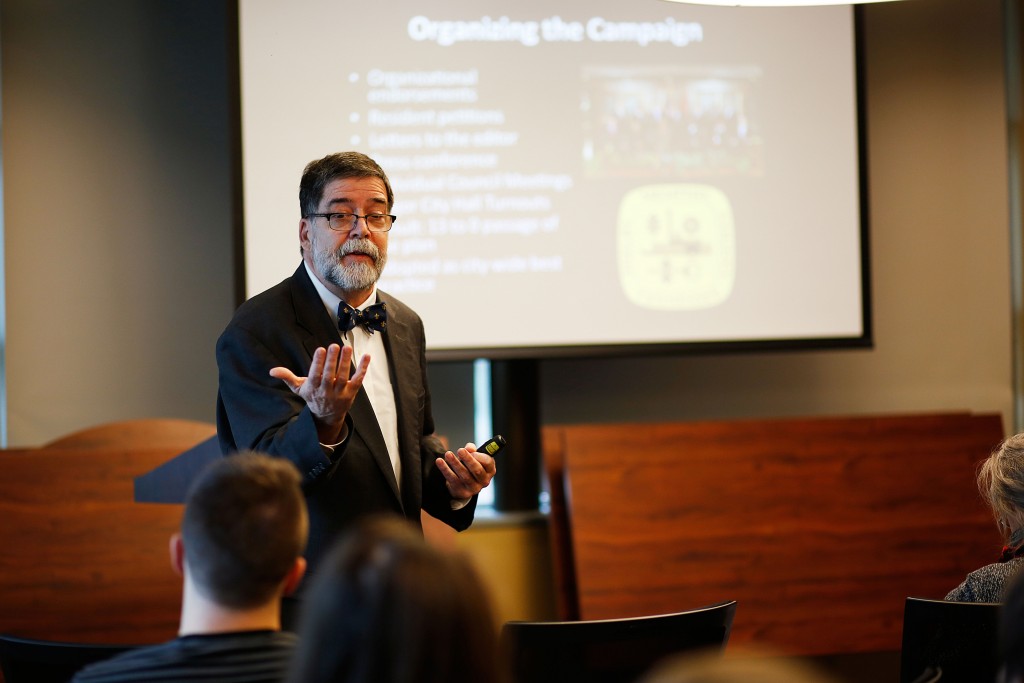
In an effort to help improve Binghamton’s neighborhoods, an award-winning urban planner came to Binghamton University and delved into his story of urban development in South Memphis.
Kenneth Reardon, a professor and the director of the graduate program of new urban planning and community development at the University of Massachusetts Boston, gave a lecture called “Overcoming the Memphis Blues through Participatory Planning, Design and Development” in the Old O’Connor Alumni Center. He described his career, which began by heading Cornell University’s New Orleans planning initiative to produce a recovery plan after Hurricane Katrina. His efforts earned him the William R. and June Dale Prize for Excellence in City Planning.
The lecture was arranged by BU assistant professor in public administration, George Homsy. He is also the organizer of the Neighborhood Heritage and Community Sustainability project at BU, an effort by students and faculty to reach out to community members and strengthen what they believe to be the city’s good qualities. Homsy, who was a former student of Reardon’s at Cornell, hoped to elicit inspiration for Binghamton’s own efforts to make the city less dangerous, have healthier food options and ultimately become a closer community.
“There are a couple of neighborhoods struggling that need community development,” Homsy said. “It’s not just about putting in businesses. It’s about connecting people. It’s about making sure that a place is safe, a place is clean, a place is sustainable. We wanted to bring in someone with a lot of experience who could make connections with our own community.”
Reardon’s speech focused on his time as planning director in Tennessee, where he rebuilt South Memphis through participatory planning and design. By collaborating with clergymen and churches across the city, he sorted out the area’s issues by establishing attainable goals that community members agreed upon.
“We had a very high unemployment rate, a very high poverty rate, one of the lowest employment rates in the city, a very high morbid obesity rate amongst children,” Reardon said. “But we were unable to address the structural causes of inequality and concentrations of poverty we were dealing with.”
Reardon and his team created the South Memphis Revitalization Action Project, which aimed to collaborate with community members to establish boundaries of each neighborhood and single out problems specific to each of them. A lack of healthy food, he said, was the biggest shared issue.
“With a large number of people, we could build a nonpartisan, political base of support for the plan so we could demand implementation,” Reardon said.
In a few months, the team transformed a vacant lot in South Memphis to a once-weekly, fully operating farmer’s market. The market became a year-round public facility and commercial kitchen that can be used by anyone in the community. Cooking classes that taught healthy ways to cook traditional African-American dishes were offered five nights a week, and a food truck to deliver healthy food options to four other areas in Memphis was established.
In addition, Reardon and his team used an $85,000 grant from a local urban art organization to build pedestrian walkways and safer bike lanes lined with sculptures and cultural art.
Katherine Dillon, a fourth-year graduate student studying archaeology, works with two professors involved in the Neighborhood Heritage and Community Sustainability project and said she hopes to use Reardon’s speech as motivation to achieve her project’s goals in Binghamton.
“We put on events to meet other people who live in our neighborhood and make connections, and find out what they want out of the neighborhood,” Dillon said. “Reardon has a lot of experience in planning and engagement. The students here that are working to make neighborhoods more sustainable could get a lot out of that and use skills to build stronger projects to help change this community for the best.”


